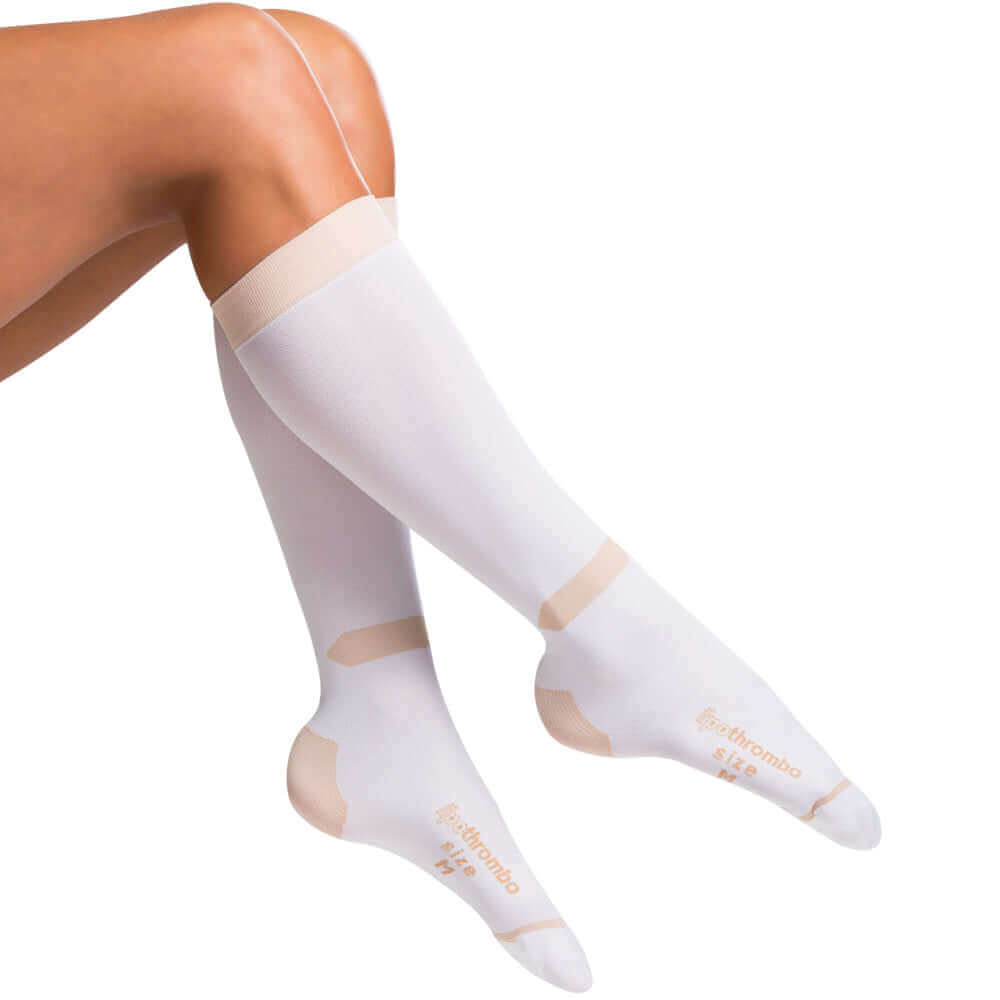LIPOTHROMBO AD
When to use the LIPOTHROMBO AD compression stockings?
- Recommended to use during any type of surgery and hospitalization to increase safety and reduce the risk of DVT.
- Regular price
- $19.90
- Regular price
-
- Sale price
- $19.90
- Unit price
- per
Free Shipping
Free standard shipping on orders over $250
Shipping within 24 business hours
When to use the LIPOTHROMBO AD compression stockings?
- Recommended to use during any type of surgery and hospitalization to increase safety and reduce the risk of DVT.
Product description
- Unisex compression knee high Anti-embolism stockings with graduated compression create sufficient pressure to walls of the surface and deep veins of legs to prevent blood stagnation and to direct blood circulation to the heart
- The graduated compression stockings reduce the risk of DVT and are proven to increase safety during any surgery
- DVT is the formation of a blood clot (thrombus) within a deep vein, primarily in legs. DVT is considered as a major health risk for patients confined to bed in hospital, which lowers the blood flow in legs, this may cause blood clotting. If the clot separates, it can travel to lungs, called Pulmonary Embolism– PE and the consequences can be fatal
- LIPOELASTIC’s compression stockings have an easy access toe opening that allows for the inspection of pedal pulse
- 18-21 mmHg
For who are they?
- For immobile patients prior to, during and after surgery
- For mothers immediately prior to and after child delivery
- For other immobile patients in lying position
- For people who have undergone liposuction of knees
Parameters
- Permeable and pleasant to the skin
- Made of materials resistant to oils and ointments
- Does not cause adverse effects
- The rim variant is designed for mobile patients with the rim preventing the stocking from rolling down
- The knit strips with letters ‘b’ or ‘d’ clearly marking measuring positions of the extremity girth
- The knit numbers and sizes marked with letters facilitate product identification
- The easily exposable toe tips facilitate circulation impact checks
- Material composition: 90 % POLYAMIDE, 10 % ELASTANE
How to put on LIPOTHROMBO anti-embolism stockings
|
Size |
b |
d |
|---|---|---|
|
|
cm |
cm |
| XS | 19-21 | 28-35 |
|
S |
21-23 |
31-38 |
|
M |
23-25 |
33-41 |
|
L |
25-27 |
35-44 |
|
XL |
27-29 |
37-47 |
|
XXL |
29-31 |
39-49 |
|
3XL |
30-33 |
41-51 |
|
4XL |
34-38 |
52-62 |
| 5XL | 39-43 | 63-75 |
| 6XL | 44-49 | 76-90 |

| Size | MEASUREMENTS IN INCHES | |||||||||
| XS | S | M | L | XL | XXL | 3XL | 4XL | 5XL | 6XL | |
| b | 7½-8 | 8 -9 | 9-10 | 10-10½ | 10½-11½ | 11½-12 | 12-13 | 13-15 | 15-17 | 17-19 |
| d | 11-14 | 12-15 | 13-16 | 14-17½ | 14½-18½ | 15½-19 | 16-20 | 20½-24½ | 25-29½ | 30-35 |

Shipping
We ship to Canada and the United States. Shipments to Canada are mailed via Canada Post. Shipment to the US are mailed via Canada Post/USPS. Orders to the USA are typically delivered within 4-8 business days, depending on the location. (This is not a guarantee, but an estimate based on previous delivery times). We are not responsible for third-party delays or lost items. Our products ship from Ottawa, Ontario. Orders received after 2pm will be dispatched the following business day. Please provide your email at checkout to receive your order and payment confirmation along with your package tracking number. Please note, orders are dispatched after payment verification. A confirmation email will be sent. Please check your SPAM box for confirmation payment email. Email will be sent confirming the order has been dispatched along with a tracking number. Shipping is calculated at checkout. Free shipping on orders of $250+ before taxes.
Return
- We advise you to consult our size charts and measure yourself twice. If you need assistance choosing the right size, please contact us for support prior to making a purchase. We do not offer product exchanges or returns for ordering the incorrect size. If a replacement garment is desired, please place a new order. All sales are final unless the garment is flawed prior to wear.
- We guarantee all LIPOELASTIC garments to be free from manufacturing flaws or defect prior to use. LIPOELASTIC garments are registered as Class I Medical Devices and are often worn post-surgery. Due to hygiene, health and safety reasons and the intimate nature of the products, all sales are final.
- Returns and exchanges must be pre-approved. A Return & Exchange Authorization (REA) can be obtained if the item is defective by contacting our Customer Support Team at contact@thescitechgroup.com within 5 days of delivery date. Please provide your order number in the subject line when making a claim. If a return/exchange is approved, items must be posted back within 48 hours or the authorization will be void. Please note that we are not refunding the shipping costs, but only the product purchase price. You will need to cover the full cost of return postage.
- All returns/cancellations are subject to a 10% restocking fee. (exclusions apply)
- Exchanges and returns must be sent via post (we recommend using a tracked delivery).
How to return garments?
Due to the medical nature of our products and for hygiene, health and safety reasons, all sales are final. Please do not send used garments as we are not obliged to accept these items.
Process of a return:
- Please obtain an REA from our Customer Support Team before sending anything back. (We will not refund/exchange products without pre-authorization.
After receiving your item, we will:
- Check the returned product(s) to ensure that they meet the required conditions. Items found to be worn/used will be discarded without an exchange/refund.
- If approved, we will issue a refund within a maximum of 7 days from processing the return.
When do you get your money back?
Once returned products have been received, we will then issue a refund within 7 days from the date of receipt of postage. Please note that we are not obliged in any way to issue a refund before the goods have been returned in their original condition or evidence of goods being returned has been provided. We will refund your money to the same form of payment used during the purchase.
All returns are subject to a 10% restocking fee unless proven to have a manufacturing defect or if the return was due to an error on our part.
We pay attention to detail and each stage of production meets all the required standards. It's important to us, to carefully select the components and materials we use, meaning we have a personal connection to each garment we produce. The materials we use for LIPOELASTIC ® Post-Surgical Compression Garments come exclusively from the European Union and each piece is manually inspected for output.
LIPOELASTIC ® products are medical devices awarded with the OEKO-TEX ® STANDART 100 certificate, 02.0.8039 Hohenstein HTTI, which guarantees the absence of harmful or allergenic substances (such as latex, etc.).


The product must be washed gently at 30ᵒC max.

Do not bleach.

Do not tumble dry.

Do not iron.

Do not clean
chemically.
- Choosing a selection results in a full page refresh.
Shop the look
Choose Options
Join Our
Mailing List
Sign Up for exclusive updates, new arrivals & insider only discounts

















